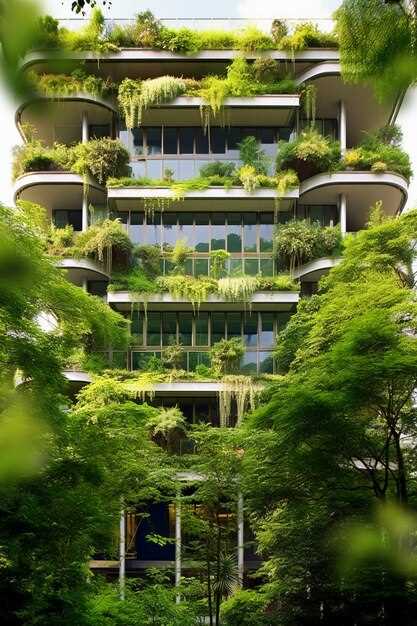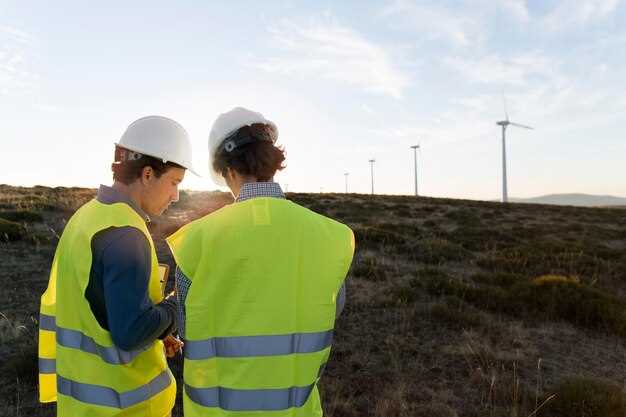In recent years, the conversation around environmentally considerate initiatives has gained significant momentum. Numerous stakeholders have started to recognize the importance of implementing intelligent techniques. This shift isn’t just a trend; it reflects a profound commitment to creating harmonious living spaces. As more individuals and organizations become aware of their ecological footprint, our shared habitat can truly transform.
Many are actively exploring alternatives to traditional methodologies. Energy efficiency is now at the forefront. Renewable resources are no longer just buzzwords; they have become practical solutions. Imagine a world where buildings seamlessly integrate with their surroundings while minimizing negative impacts, fostering a sense of responsibility and care.
Innovations in materials and design are reshaping the way we think about development. Local sourcing of resources enhances the connection to the environment. Moreover, reducing waste becomes an achievable goal rather than a distant dream. The possibilities are endless, paving the way for a different approach to how we envision spaces.
Collaboration among various disciplines is essential for progress. Architects, engineers, and environmental scientists are coming together like never before. This cross-disciplinary synergy allows for creative solutions that prioritize ecological balance. It encourages a dialogue that leads to more resilient and adaptive living spaces.
As we delve deeper into this topic, we will discover the meaningful ways in which those involved are making impactful changes. The stories and strategies uncovered will illuminate the path forward, guiding us toward a more conscientious approach that benefits everyone. This exploration will not only inspire but also empower action, encouraging others to participate in this transformative journey.
Sustainable Construction Practices in Australia

In recent years, the focus has shifted towards environmentally-conscious building methods. This movement emphasizes efficiency and harmony with nature. It seeks to minimize negative impacts while enhancing the wellbeing of inhabitants. Innovative techniques and materials play a crucial role in this transformation.
- Renewable energy sources integrate into designs.
- Water conservation methods are prioritized.
- Waste reduction strategies are essential.
- Local materials support regional economies.
By employing cutting-edge solutions and guidelines, professionals in the field aim to create spaces that not only serve their functions but also promote ecological balance, ensuring that future generations can enjoy a healthy environment.
- Utilization of green roofs for insulation.
- Incorporation of passive solar design to harness sunlight.
- Use of recycled materials reduces resource consumption.
- Innovative waste management practices enhance site efficiency.
Moreover, the collaboration between various stakeholders–architects, engineers, government bodies, and local communities–is essential in fostering a mindset oriented towards preserving natural resources while meeting the needs of the current population.
Building a Greener Future for Communities

Creating a more harmonious environment involves thoughtful approaches and innovative solutions. Engaging local populations enhances shared spaces and promotes well-being. Healthy ecosystems and resilient areas foster connections among residents. Thoughtfulness in our methods can lead to lasting positive impact.
The integration of eco-friendly materials, energy-efficient technology, and nature-based designs helps cultivate vibrant areas. This encourages a strong sense of belonging and identity while reducing ecological footprints. By prioritizing community input, we can achieve remarkable results.
Every decision counts in shaping surroundings that support diverse needs. Incorporating practical ideas not only addresses immediate concerns but also paves the way for long-term benefits. Improved air quality, access to green spaces, and community pride emerge from conscientious efforts.
Citizen involvement is vital. When people feel heard, they become invested in their environment. Collaborations among residents, local authorities, and experts can lead to inventive solutions that meet current and future challenges. Shared visions can transform ordinary places into remarkable destinations.
The significance of inclusivity cannot be underestimated. Every voice shapes the larger narrative. Engaging everyone ensures the development reflects the unique essence of each locality. Thus, we forge pathways toward thriving ecosystems, cultivating bonds that last through generations.
Importance of Sustainable Building Practices
Emphasizing eco-friendly methods in development is essential. These approaches not only reduce environmental impact but also enhance quality of life. Embracing responsible methods creates healthier living spaces. Engaging in these methods fosters a sense of community and connection.
Resource conservation is a critical component in today’s design philosophy. By optimizing energy use, we significantly lower costs over time. This includes employing innovative technologies and utilizing renewable resources. Furthermore, creating structures with longevity helps to mitigate waste.
Involving local communities in the planning phase is invaluable. It encourages collaboration and considers the specific needs of residents. Engaging with the population builds trust and ensures that projects align with their expectations. This process nurtures a sense of ownership and pride among inhabitants.
The overall benefits extend beyond individual projects. Eco-conscious methods can boost local economies by creating new jobs. Manufacturers and suppliers can thrive as demand for green materials increases. These actions contribute to a larger movement toward environmental responsibility.
In conclusion, the shift towards eco-friendly methods in development is not merely a trend; it represents a necessary evolution in how we interact with our environment. By integrating innovative strategies, we pave the way for resilient ecosystems and thriving populations. The implications of such a transformation resonate deeply within the social fabric of our society.
Community Engagement in Eco-Friendly Initiatives
Active participation of local residents is crucial in green initiatives. It fosters a sense of ownership and responsibility. When people engage, they feel connected to projects. This connection often leads to more effective results. Collaboration between various stakeholders creates opportunities for innovation and positive change.
Inviting community members to share their ideas can open up new possibilities for eco-friendly endeavors. Whether through workshops, forums, or social media platforms, dialogue is essential. Engaging the public not only ensures that their needs are met, but also empowers them in the decision-making process. This participatory approach can inspire enthusiasm and motivate individuals to adopt more environmentally conscious behaviors.
Involving locals also helps to raise awareness about sustainability issues. Initiatives that prioritize education and outreach can transform mindsets. When communities understand the environmental impact of their choices, they are more likely to alter their habits. This shift creates a ripple effect, encouraging others to join in on the journey toward a healthier environment.
Moreover, partnerships with local organizations can amplify outreach efforts. Collaborating with schools, nonprofits, and businesses can create a unified front. By pooling resources and expertise, communities can launch impactful initiatives that resonate deeply. This synergy not only enhances effectiveness but fosters deeper connections among residents.
Ultimately, community involvement is a cornerstone of any environmental initiative. It is not just about implementing projects; it’s about cultivating a culture of care and cooperation. When everyone is engaged, the journey becomes a shared experience. Together, strides can be made toward a more environmentally friendly world.
Innovative Materials for Sustainable Development
In an era where ecological awareness is paramount, fresh approaches in material selection have gained traction. The quest for extracting resources that minimize environmental impact is more pressing than ever. Striking a balance between functionality and responsibility is crucial. Newer options are emerging, redefining how we perceive material usage in various projects.
Recycled components have gained significant popularity. They provide an effective way to reduce waste. Utilizing previously discarded items can lead to creative solutions. An array of industries are now embracing these novel materials. For instance, products made from reclaimed wood not only look appealing but also tell a story of sustainability.
Moreover, bio-based alternatives are making waves in the field. Organic materials derived from natural sources present fascinating capabilities. Bamboo, hemp, and mycelium are just a few examples of innovative resources that excel in both performance and eco-friendliness. The multifunctional nature of these options opens doors to various applications, promoting a more responsible approach to resource utilization.
In addition to that, advancements in technology have improved material efficiency. Smart materials are being developed to adapt to environmental conditions. These can lead to better energy management and optimization in structures. The potential for reducing resource consumption while enhancing durability is significant. As we continue to explore innovative avenues, the intersection of creativity and responsibility becomes ever more apparent.
Ultimately, the future of material innovation rests on collaboration and experimentation. By encouraging interdisciplinary partnerships, stakeholders can drive the adoption of new concepts. Together, we can redefine the landscape of resource usage, making impactful choices for the world we inhabit. As we embrace innovative materials, we set the stage for a brighter, more conscientious reality.
Regulatory Frameworks Supporting Green Construction
The role of regulatory structures in promoting eco-conscious building methods cannot be overstated. These frameworks serve as essential guidelines. They help align development goals with environmental objectives. Through various policies and incentives, stakeholders are encouraged to adopt innovative solutions. The heightened focus on quality and responsibility marks a significant shift in the industry.
Legislation plays a key role. It provides a pathway for organizations to implement advanced techniques. Numerous governmental bodies have established regulations aimed at minimizing ecological footprints. Compliance with these laws often leads to cost savings and enhanced reputability. Moreover, many regions have initiated partnerships aimed at fostering collaboration among various sectors.
- Building Codes: Standards that promote energy efficiency.
- Financial Incentives: Grants and tax deductions for environmentally-friendly initiatives.
- Certification Programs: Recognition for meeting high environmental standards.
- Land Use Planning: Strategies that prioritize low-impact development.
In Australia, green building guidelines exist alongside traditional codes, creating a more comprehensive regulatory environment. The integration of different frameworks is crucial for fostering innovations, ensuring that new developments not only comply with existing rules but also embrace forward-thinking approaches that prioritize the well-being of both residents and the planet. By aligning economic growth with ecological integrity, these regulations pave the way for lasting change.
Many local governments actively engage with communities. They host forums to discuss sustainable ideals and gather public input. Such initiatives bolster transparency and encourage social responsibility among builders and developers alike. Consequently, this leads to the evolution of standards that reflect the needs and values of contemporary society.
- Consultation with stakeholders during policy formulation is vital.
- Regular updates to regulations ensure relevance and effectiveness.
- Support programs assist small businesses in compliance efforts.
Ultimately, a multifaceted approach strengthens these legislative frameworks. With the collective effort of various entities, the vision for an environmentally conscious landscape becomes increasingly attainable. As regulations evolve, they not only set expectations but also inspire proactive measures toward a more responsible approach to development.
Exploring Sustainable Furniture Options

The choice of furniture can greatly impact our environment. Many people seek alternatives that reflect their values. Today, options exist that prioritize ecological health and resource efficiency. With increasing awareness, designers are responding to consumer demand.
While traditional materials often contribute to waste and pollution, contemporary choices embrace renewable resources. These innovative items not only reduce environmental harm but also enhance the aesthetics of spaces. Buyers are now considering the lifecycle of furniture in their selections.
From reclaimed wood to recycled metals, the variety is impressive. Upholstery made from organic fabrics has gained popularity. Moreover, furniture that utilizes low-impact manufacturing techniques often finds favor. Such selections can contribute to healthier living environments.
| Material | Benefits |
|---|---|
| Reclaimed Wood | Reduces deforestation; adds character to each piece. |
| Recycled Metal | Minimizes landfill waste; highly durable and easy to maintain. |
| Organic Fabrics | Free from harmful chemicals; provides a more breathable experience. |
| Bamboo | Fast-growing; renowned for strength and versatility. |
As we explore these options, it’s clear that thoughtful choices in furniture can reflect a deeper commitment to environmental stewardship. Investing in such designs ensures that not only do we enhance our living spaces, but we contribute positively to the planet as well.
Benefits of Recycled Wood Furniture
Choosing furniture made from reclaimed timber brings numerous advantages. This decision positively impacts our environment while also enhancing our living spaces. Each piece tells a story, rich in character. Moreover, it fosters a sense of uniqueness that mass-produced items simply can’t replicate.
One of the primary benefits is the significant reduction in waste. By utilizing salvaged wood, we help decrease the demand for new resources. This process minimizes deforestation, preserving biodiversity. Furthermore, reused materials often require less energy to process than new products.
Durability is another advantage. Recycled wood carries its history, often being more resilient than newly harvested counterparts. It has already weathered the test of time, which means it is less likely to warp or suffer damage. Many artisans craft these pieces with skill and care, ensuring quality and longevity.
Besides environmental benefits, recycled wood furniture offers aesthetic appeal. Each item has its own unique features, including knots and varying textures, which add to its charm. This individuality contributes to the character of any room. Rather than blending in, these pieces often become focal points, sparking conversation.
Cost savings can also be significant. Much of the reclaimed wood is more affordable than purchasing new timber, making stylish and eco-friendly choices accessible. With furniture that is both budget-friendly and visually appealing, consumers can enjoy a balance of functionality and artistry.
In summary, embracing recycled wood furniture not only benefits personal spaces but also supports broader environmental goals. Each choice contributes to a larger movement towards responsible consumption, appealing to those who value both style and substance.
Characteristics of Reclaimed Wood Design
The allure of reclaimed timber lies in its unique charm and character. Each piece tells a story, often showcasing the marks of its previous life. This material is not only aesthetically pleasing but also steeped in history. Its use brings a warm, rustic touch to any space.
Typically sourced from old buildings, barns, and even pallets, it embodies a blend of tradition and innovation. When applied thoughtfully, reclaimed wood provides numerous benefits beyond its appealing surface. It stands out in versatility, offering endless creative possibilities for design enthusiasts. Further, it contributes to an eco-conscious approach in material selection.
Another key aspect is durability. Reclaimed wood is often more robust than new timber, having already withstood the test of time. Moreover, its age enhances its appearance, revealing natural grains and textures that newer wood may lack. This authenticity is highly sought after in modern design.
| Benefits | Drawbacks |
|---|---|
| Unique aesthetics | Possible structural imperfections |
| Environmentally friendly | Higher initial cost |
| Durability | Limited availability |
The character of reclaimed wood is truly unmatched, reflecting both nature’s artistry and human history while offering a plethora of design possibilities that can enhance any interior or exterior space. By considering its properties, one can create a beautiful environment that respects both the past and the present.
Eco-Friendly Materials in Modern Furniture
In recent times, there has been a significant shift towards embracing materials that are gentle on the environment. This trend not only promotes healthier living spaces but also enhances the aesthetic appeal of homes and offices. Creating furniture from these innovative components reflects a growing awareness and responsibility toward our planet. Consumers are increasingly valuing the beauty and durability of items made from natural and recycled resources.
Various materials stand out in this eco-conscious approach:
- Bamboo: Fast-growing, renewable, and incredibly strong.
- Recycled Wood: Repurposed from old structures, this adds character to any piece.
- Cork: Harvested from the bark of cork oak trees, it’s both lightweight and sustainable.
- Organic Fabrics: Materials like hemp and organic cotton are free from harmful chemicals.
Moreover, the use of reclaimed metals has garnered attention, as they carry a unique history and reduce the demand for new mining activities. With a focus on reducing carbon footprints, many manufacturers are now opting for water-based finishes and non-toxic adhesives that do not compromise indoor air quality, thus fostering healthier living environments. The combination of aesthetic appeal and environmental awareness is becoming a hallmark of modern design.
Investing in furniture made from such materials not only showcases a commitment to responsible consumption but also inspires future generations to prioritize the health of our planet. This growing movement encourages artisans and designers to think creatively, leading to exciting developments in the world of home decor.
Video:
Transform Your Home: How Sustainable Construction Creates a Greener Tomorrow with SPARS Constructs!
Transform Your Home: How Sustainable Construction Creates a Greener Tomorrow with SPARS Constructs! by Spars Constructs 186 views 12 days ago 4 minutes, 41 seconds
Q&A:
What are the key sustainable construction practices being implemented in Australia?
Sustainable construction practices in Australia include the use of renewable materials, energy-efficient designs, and water conservation techniques. Key practices involve the integration of solar panels, the use of recycled materials like reclaimed wood and metal, and the application of green building certifications such as Green Star. Additionally, passive design principles that promote natural ventilation and daylight utilization are increasingly popular, helping to minimize the environmental impact of new constructions.
How do sustainable construction practices benefit the community and environment?
Sustainable construction practices offer numerous benefits for both the community and the environment. They contribute to reducing carbon footprints, improving air and water quality, and conserving natural resources. From a community standpoint, sustainable buildings often lead to cost savings on energy bills for residents and businesses, create healthier living and working environments, and enhance the overall quality of life. Moreover, these practices promote local economies by using local materials and labor, thus supporting community development.
What role does the government play in promoting sustainable construction in Australia?
The Australian government plays a significant role in promoting sustainable construction through various policies, regulations, and incentive programs. This includes implementing building codes that encourage energy and water efficiency, offering financial incentives for green building initiatives (like grants or tax rebates), and supporting research and development in sustainable building technologies. Additionally, government-led initiatives such as the National Australian Built Environment Rating System (NABERS) help to benchmark and improve the sustainability performance of buildings, which influences industry standards.
What challenges does the sustainable construction industry face in Australia?
Despite its growth, the sustainable construction industry in Australia faces several challenges. These include higher initial costs associated with eco-friendly materials and technologies, a lack of awareness or knowledge among consumers and builders about sustainable practices, and regulatory hurdles that can slow the adoption of innovative solutions. Additionally, market demand for sustainable buildings can be inconsistent, creating uncertainty for developers. Education, policy reform, and increased collaboration among stakeholders are essential to overcoming these challenges and driving further progress in sustainable construction.
What can homeowners do to implement sustainable practices in their own construction or renovation projects?
Homeowners can take several steps to incorporate sustainable practices into their construction or renovation projects. First, they can opt for eco-friendly materials such as bamboo flooring, recycled insulation, and low-VOC paints. Implementing energy-efficient features, like solar panels, high-efficiency appliances, and proper insulation, is also crucial. Homeowners should consider the orientation and layout of their homes to maximize natural light and ventilation. Additionally, engaging with qualified builders who specialize in sustainable practices can ensure that projects meet green standards and utilize best practices in design and construction.
What are some key sustainable construction practices being adopted in Australia?
Some key sustainable construction practices in Australia include the use of environmentally friendly materials, water-efficient systems, energy-efficient designs, and waste reduction strategies. Builders are increasingly opting for recycled or sustainably sourced materials, such as bamboo and reclaimed timber. In addition, the integration of renewable energy systems like solar panels and rainwater harvesting systems is becoming more common. These practices not only reduce the environmental impact of construction but also contribute to long-term energy and water savings for the occupants of these buildings.
How do sustainable construction practices benefit local communities in Australia?
Sustainable construction practices offer numerous benefits to local communities in Australia. Firstly, they enhance the overall quality of life by creating healthier living environments, minimizing pollution, and promoting biodiversity through the use of green spaces and sustainable landscaping. Secondly, energy-efficient buildings can lead to lower utility costs for residents, freeing up funds for other essential needs. Additionally, implementing these practices supports local economies by creating jobs in the sustainable building sector and encouraging the development of local suppliers of green materials and technologies. Moreover, by investing in sustainability, communities can better adapt to the challenges posed by climate change, ensuring a resilient future for residents and future generations.
